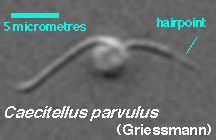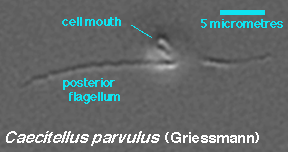
Live detached cell (not
gliding),lateral view
Caecitellus cells are encountered as very small naked trophic cells, which are rarely observed swimming but are commonly seen gliding along surfaces.
 Live detached cell (not gliding),lateral view |
Gliding cells, which are uninucleate, are roughly spherical and only 2-7 Ám in diameter. The two flagella are subapically inserted. The anterior flagellum is directed forward, slowly sweeping from left to right as the cell moves forward. At the end of this flagellum is a hairlike tip ("hair point"), which may be as much as half the length of the flagellum. The posterior flagellum extends behind the cell and, when appressed to substrate, provides the motive force for gliding. The cell changes direction by bending the posterior flagellum. |
 Gliding cell, ventral view | A horseshoe-shaped cell mouth ("cytostome") appears on the right ventral side of the cell behind the flagellar insertion - the position and shape of this cell mouth helps distinguish Caecitellus from other small gliding zooflagellates. It is presumed that, while gliding, the anterior flagellum sweeps food particles (bacteria, possibly also detrital materials) towards the cytostome, where they are captured and ingested. |
Return to summary information